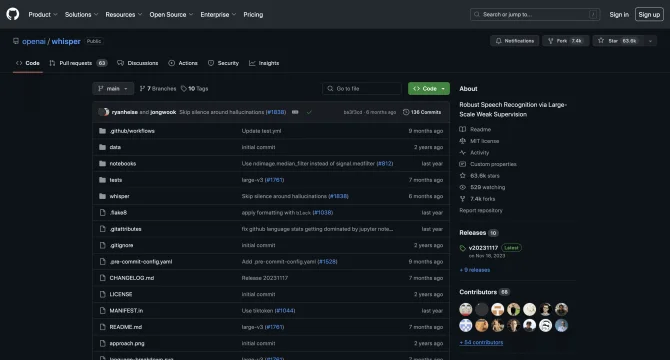Introduction
Whisper is a groundbreaking speech recognition model that stands out for its robust performance and versatility. It is trained on an extensive dataset of 680,000 hours, covering a multitude of languages and speech tasks, which allows it to transcribe audio into text with remarkable precision. The system's architecture is based on a Transformer model, utilizing encoder-decoder mechanisms to process audio inputs efficiently. The model's innovative approach to handling audio in 30-second chunks and converting them into log-Mel spectrograms for decoding sets a new standard in the field. Whisper's deployment flexibility, with options for cloud services and local deployment, caters to a wide range of user needs, making it accessible for various applications.
background
Developed by OpenAI, Whisper represents a significant leap forward in the field of automatic speech recognition. Its open-source nature encourages community contribution and innovation, fostering a collaborative environment that propels the technology forward. The model's training on a diverse dataset ensures that it is not only accurate but also adaptable to various accents and speaker traits, making it a truly global solution.
Features of Whisper
Multilingual Support
Whisper supports 98 languages, providing a wide-reaching tool for global users.
Multitask Capabilities
Beyond transcription, Whisper can perform tasks such as language identification and translation.
High Accuracy
With an 85.5% accuracy rate for English and 80.1% for Chinese, Whisper leads in precision.
Flexible Deployment
Users can deploy Whisper via cloud services or on local infrastructure.
Transformer Architecture
Utilizes an encoder-decoder Transformer model for efficient audio processing.
How to use Whisper?
To use Whisper, users can follow a simple deployment process using Docker, access it via a web interface, and interact with it through HTTP interfaces for speech recognition and language detection.
Innovative Features of Whisper
Whisper's innovation lies in its ability to handle a vast array of languages and tasks with a single model, its high accuracy across diverse datasets, and its open-source accessibility for community enhancement.
FAQ about Whisper
- What languages does Whisper support?
- Whisper supports 98 languages, covering most global regions.
- How accurate is Whisper's speech recognition?
- Whisper achieves high accuracy rates, with 85.5% for English and 80.1% for Chinese.
- Can Whisper be deployed locally?
- Yes, Whisper offers flexible deployment options including local deployment.
- How does Whisper handle different accents?
- Whisper's training on diverse datasets allows it to robustly handle various accents.
- What are Whisper's system requirements?
- Whisper can run on ordinary configurations without the need for high-end hardware like GPUs.
Usage Scenarios of Whisper
Academic Research
Researchers use Whisper for analyzing speech patterns and accents in linguistic studies.
Customer Service
Companies implement Whisper to enhance customer service with automated speech recognition.
Smart Home Devices
Whisper integrates with smart home devices for voice-activated control.
Multilingual Content Creation
Content creators leverage Whisper for accurate transcription and translation services.
User Feedback
Users have praised Whisper for its ability to transcribe audio with high accuracy, even in noisy environments.
Developers appreciate the open-source nature of Whisper, allowing for easy integration and customization.
Whisper has been noted for its user-friendly interface, making it accessible for non-technical users.
The model's support for a wide range of languages has been highlighted as a key advantage by multinational corporations.
others
Whisper's open-source nature has spurred community-driven innovation, leading to continuous improvements and new use cases. It has been successfully deployed in various sectors, including education, healthcare, and legal transcription services, where its accuracy and efficiency have significantly streamlined workflows.
Useful Links
Below are the product-related links, I hope they are helpful to you.
